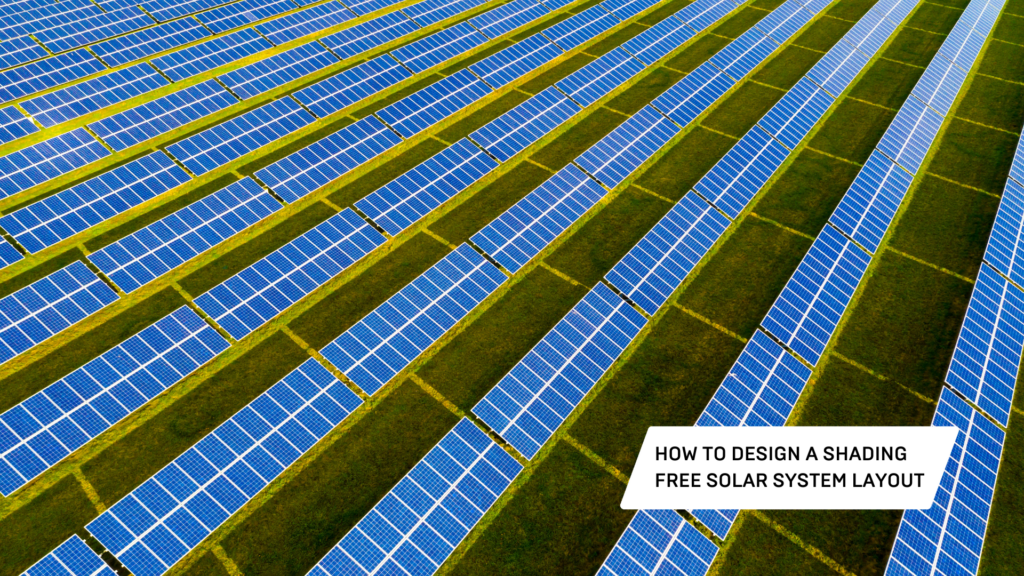Solar energy is one of the most abundant and sustainable sources of power available to us. To harness its full potential, it’s crucial to design solar plants that are free from shadows. Shadows can significantly reduce the efficiency of solar panels and, if not addressed properly, lead to financial losses and decreased environmental benefits.
In this blog, we’ll explore the key considerations and strategies to design a shadow-free solar plant, ensuring it operates at its peak performance and contributes to a greener future.
Procedure of Designing
Site Selection and Layout:
First crucial step for designing any solar plant is to select the right location. Right location indicates a site with minimal shading potential throughout the day. For better understanding of the location conduct a thorough shade analysis, taking into account the seasonal variations in the sun’s path. One more thing to keep in mind, is to opt for an open, unobstructed area whenever possible and consider factors like terrain, local climatic conditions.
Tilt and Orientation:
The tilt angle and orientation of solar panels play a significant role in minimizing shadow. Panels should be tilted and oriented to maximize exposure to sunlight throughout the day and year. This may require different angles for summer and winter months. By optimizing panel tilt and orientation, we can reduce the chances of shadows falling on the panels.
Tilt and Orientation plays a vital role in avoidance of shadow
Link : https://www.bbc.com/future/article/20200803-the-solar-canals-revolutionising-indias-renewable-energy
Row and Panel Spacing:
While designing, careful planning of the spacing between rows and individual panels is essential to prevent self-shading. Avoid placing panels too closely together, as this can lead to shadows falling on adjacent rows during certain times of the day.
Solar Tracker Systems:
Utilizing solar tracking systems can significantly enhance energy capture by adjusting the orientation of solar panels throughout the day to follow the sun’s movement. Single-axis and dual-axis tracking systems are available, with the latter offering more precise alignment. While these systems increase complexity and costs, they can greatly boost overall efficiency.
Solar tracker system help’s solar panel in following the sun’s path
Link : https://lgoodov.xyz/product_details/14943919.html
Vegetation Management:
Regular maintenance of the surrounding vegetation is crucial for preventing shadows on solar panels. Trees and shrubs should be strategically planted, pruned or removed to ensure they do not cast shadows during peak sunlight hours.
Advanced Technologies :
Implementing advanced monitoring and control systems like bypass diodes, string inverters, etc., enables real-time tracking of the solar plant’s performance. These systems can detect shading issues promptly and make automatic adjustments to optimize energy production.
Conclusion
Designing a shadow-free solar plant is crucial to maximize energy production, increase system longevity. By addressing these key considerations, solar power plants can contribute significantly to the global shift towards sustainable and clean energy sources.
Join our SafEarth marketplace to explore your options and buy your solar system from qualified installers in your area to make the switch easy.


My brother suggested I might like this website He was totally right This post actually made my day You cannt imagine just how much time I had spent for this information Thanks
Wow Thanks for this page i find it hard to track down great tips out there when it comes to this content thank for the thread website
Wow Thanks for this write-up i find it hard to locate really good info out there when it comes to this content appreciate for the review website
Wow Thanks for this guide i find it hard to come up with very good details out there when it comes to this content thank for the thread site
Wow Thanks for this thread i find it hard to come across decent facts out there when it comes to this subject material appreciate for the blog post site
Wow Thanks for this blog post i find it hard to discover exceptional important information out there when it comes to this subject matter thank for the article website
Wow Thanks for this review i find it hard to acquire good information and facts out there when it comes to this blog posts thank for the content site
nice blog mate.. amazing content.. this one i search for. thank you
Wow Thanks for this posting i find it hard to obtain exceptional answers out there when it comes to this topic thank for the article website
Wow Thanks for this page i find it hard to uncover very good data out there when it comes to this subject material appreciate for the publish website
Wow Thanks for this publish i find it hard to realize good quality important info out there when it comes to this subject material thank for the review site
Wow Thanks for this posting i find it hard to get exceptional particulars out there when it comes to this topic appreciate for the thread site